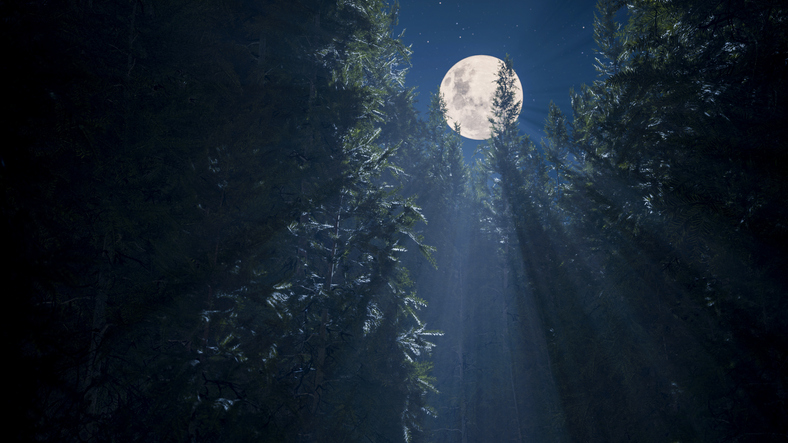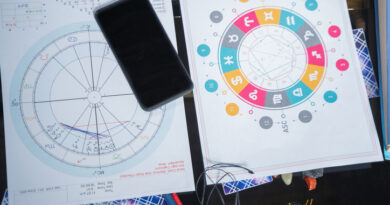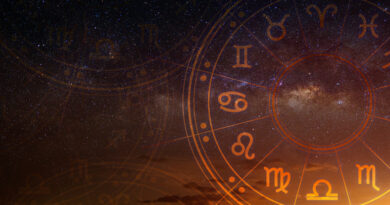The Eight Phases of the Moon

As Earth orbits the Sun, the Moon orbits Earth, reflecting the Sun’s light back to us. The Sun is always lighting the side of the Moon that faces it, but we don’t always see the illuminated side as the Moon circles us approximately monthly. Over the course of about fourteen nights, the light of the Moon waxes, growing more full as each night passes, until a seemingly perfect circle shines in the heavens. Then the Moon’s light begins to visibly wane, returning over another fourteen nights to darkness until the Moon’s light diminishes entirely. The Moon is dark once more until the cycle begins again. This cycle repeats about every twenty-nine days.
As the saying goes, “As above, so below.” The waxing and waning of the Moon is a symbol of life itself, ingrained into human consciousness. Just as we are born, grow, and die, the Moon seems to do so as well. We can tap into this lunar symbolism by aligning our intentions and actions with the energy of the current lunar phase.
During the waxing half of the lunar cycle, the light is growing and expanding, symbolizing a good time for things here on Earth to expand and grow as well. It’s a good time to plant and nurture seeds, to set plans in motion, and act on our desires. There is a sense of things building.
During the waning half of the lunar cycle, the light is diminishing, symbolizing a time to reap what we’ve sown, and to review, let go, and surrender. It is a good time to release things that have run their course and close doors that have stood open too long. Near the end of the waning phases, we can cleanse and prepare for the renewal of the cycle.
The Lunar Phases
While this light cycle of the Moon is continuous and unbroken, eight lunar phases offer a way to mark the transitions in the shape of the Moon’s reflected light during its monthly cycle. The phases are typically known as the new, waxing crescent, first quarter, waxing gibbous, full, waning gibbous, third quarter, and waning crescent phases.
The Moon’s entry into each of these phases is not necessarily as exact as the chime of a clock striking the hour; in fact, four of these phases mark a threshold and the other four represent the journey toward the next threshold. The four crescent and gibbous phases (both waxing and waning) are not moments in time but periods between the thresholds when the Moon could be said to be “crescenting” or “gibbous-ing” as it makes its way from new to full and back to new again.
Finding the Moon
Just like the Sun appears to rise and set, so does the Moon, rising and setting about an hour later each day as it moves around the Earth in its orbit. In its waxing phase, it is often too close to the Sun to see properly until after the Sun has set. As it gets further along in its cycle of phases, its position in the sky is more distant from the Sun, making it easier to see for longer periods of time, even sometimes during the daylight hours.
The Moon’s light always grows from right to left in the northern hemisphere, and left to right in the southern hemisphere. It is delightfully simple to recognize whether the Moon is waxing or waning just by sight—just give yourself a “hand.” Hold your right hand up to the Moon. If the curve of your hand between your index finger and thumb corresponds to the curve of the light side of the Moon, the Moon is waxing. If it’s the opposite, the Moon is waning, and the curve of the light side of the Moon will correspond to your open left hand instead. In the southern hemisphere, this is reversed—simply switch hands to perform this lunar magic trick!
The Phases
New Moon (Dark Moon)
The Moon cannot be seen in the sky when in its new phase. The lit side of the Moon faces away from us, and the night sky is illuminated only by starlight. A New Moon rises and sets in relative unison with the Sun, too close to it to be seen.
The phases of the Moon represent a never-ending cycle, but the period of the New Moon is often considered the beginning, the renewal, of this cycle, and it is a good time for your own beginnings, to act on what you’ve been planning or to try something new. This is a time for experimentation and spontaneity.
This phase is sometimes referred to as a dark Moon (for obvious reasons). During this phase, there is no guiding light on the path. This is a phase of instinct, a time when we must feel our way forward. It is a good time to try something new or take a step in a good direction, even if you don’t know where it will lead. The New Moon is a time to act on things that are meant to grow, like a seed being planted. Hope and enthusiasm, even if seemingly naïve, are the attitudes to embrace.
If you were born during a New Moon phase, you are learning to trust what you know inside and act on it with faith in your inner guidance system, even if you don’t always end up where you’d hoped you would.
Waxing Crescent Moon
As the light of the Moon moves from total darkness to the balance of light and dark at the first quarter phase, a crescent of light grows. The waxing crescent Moon is an early riser, getting up just after sunrise. This Moon is difficult to see during the day but look to the west to see her just after sunset. The farther along from the New Moon phase, the easier it is to spot the Moon in this phase.
Both the new and waxing crescent phases of the Moon have a feeling of spring about them—the enthusiasm of bursting into the world and a sense of being at the beginning of something just starting to get underway. The seed that was planted now begins to push a tiny sprout above the soil.
A sense of momentum is present in this phase, as the growing light gains more ground each night. It is a good time to seek out sources of inspiration and support to keep up the projects or goals you’ve begun and continue to put forth an enthusiastic effort.
If you were born during a waxing crescent Moon, you are deeply in tune with potential and possibility and may feel most nourished when you are able to express your heart through a sense of mission or purpose. You are learning how to follow through on the things that matter most over time.
First Quarter Moon
At the first quarter Moon, the waxing light appears balanced: half of the face of the Moon lies in darkness and half is illuminated. This Moon can be easily seen moving through the sky for most of the day, setting in the west around midnight.
A sense of anticipation prevails during this phase. The seed has now grown beyond just a small sprout but has not yet produced blossoms.
This threshold is a tipping point. From here until the Full Moon phase, the scales will tip toward the light side, like spring expanding into summer. It is not uncommon to experience bumps in the road, and this phase is a good time to confront obstacles and acknowledge conflicts to work past any stalled energy. In the previous phase, you needed to build momentum; here, you need courage and conviction to continue moving forward. You may feel like you have something to prove, although possibly only to yourself.
If you were born during this phase, you are likely to fight for what you feel is important rather than live in complacency but may struggle with overconfidence and impatience.
Waxing Gibbous Moon
Throughout the waxing gibbous phase, there is more light than dark. You can see the Moon rising in the east later in the day and setting later at night, well past midnight in the west as this phase progresses.
After the make-or-break, confrontational feeling of the first quarter Moon, a sense of promise embodies this phase. Now the seed has grown into a plant and is beginning to sprout buds—there is no need to prove yourself because the result, though not fully grown, can start to speak for itself.
This is a good time to seek out assistance from those who can reinforce your confidence in yourself and the goals and projects you have undertaken. This can also be a social time where a sense of collaboration, formal or informal, is most beneficial. This is still a waxing phase so there is still something building, but the angst and fervor present in the earlier phases is more relaxed now. It’s a good time for activities that require patience, continued effort, and some fine-tuning.
If you were born under a waxing gibbous Moon, you may find you have an instinct for supporting and connecting with others on many levels, not because you are necessarily an extrovert, but that you have a knack for collaboration and bringing ideas and people together.
Full Moon
At the full phase, the light has reached its maximum. It rises in the east as the Sun sets, illuminating the sky throughout the night and setting in the west as the Sun rises again. The Moon shines bright and clear; the plant’s buds open fully into blossoms.
If you have something to reveal or express, now can be a good time to do so, even if you are not sure you are ready. Share, socialize, and let the world see what you are and hear what you have to say.
There may be a sense of exposure during this phase. It can seem that everything is running at high power when the Moon is full, including our emotions. Whatever has been brewing and building now manifests; for good or ill, it comes into full view.
It is common for things to feel like they are coming to a head during this time, or something not previously seen is now in full view. The Full Moon can bring revelations, even if there isn’t necessarily understanding or clarity.
None of us are perfect, but if you were born during the full phase, you are meant to lay all your beauty out bare to the world, ready or not. You are learning to be comfortable with your humanness and foibles and not let embarrassment, fear, or shame hold you back from your sincerest expression of self.
Waning Gibbous (Disseminating) Moon
The light from the Full Moon is now waning, with the Moon rising later each day after sunset and setting in the west after dawn.
In this “afterglow” phase just past the Full Moon, the light begins to wane, the blossoms becoming overripe and drooping under their own weight. This lunar phase is sometimes called the disseminating phase, symbolizing a time to share what you’ve learned and gather feedback from others. Recently completed projects, especially of a creative nature, may feel like they are taking on a life of their own.
You may have an intuitive sense of things beginning to come to an end. The fast, building pace of the waxing phases can feel too manic in the waning phases. It is a time to review what is working, what has worked, and what’s no longer working. Seek some objectivity and distance if a situation has been dominating your time or emotions. If things have been culminating, there may be a sense of letdown that might be simultaneously a relief on some level, depending on your feelings about the outcome.
If you were born under this phase, you may have the heart of the philosopher or teacher, with a desire to share a message or bring others to clarity. You are learning to let go of how others receive your message and simply find fulfillment in giving and wisdom.
Last (Third/Reconciling) Quarter Moon
The face of the Moon is once again divided down the center, a moment of balance before giving way to the growing dark. The Moon rises in the east near midnight during this phase and sets in the west well after sunrise.
This threshold is a good time to break through stalled energy by confronting and releasing anything that needs to be let go. This Moon is sometimes called a reconciling Moon, symbolizing a good time to take stock and see if we are holding on to anything—be it circumstances, objects, or relationships—that has already run its course, and to wrap things up and put things in order.
The plant that has long since flowered and produced fruit is now ready to die and return to the earth, but it cannot if we cling to it or prop it up. If something in you or a situation you are in is ready to collapse and give way to change, this phase is a good time to acknowledge fears that may be standing in the way. Acknowledge what you intuitively see coming. Releasing feelings of sorrow and surrendering to the natural course can ultimately bring relief.
This phase is also a good time to begin to consolidate our energy, to draw energy inward rather than expel it outward. Save money rather than spend, use what you have rather than acquire something new; the beginning of this phase may carry more angst but reflection, meditation, and rest are in alignment with this phase as it progresses farther toward the crescent.
If you were born during this phase, you may feel caught between two instincts: the instinct to engage with the world, share your wisdom, make things happen, fight the good fight, and the instinct to disengage. You may be a bit of a nonconformist by default as you strive to keep the balance between living in the world but not being a product of it.
Waning Crescent (Balsamic) Moon
During this last phase, the Moon rises in the east well after midnight, rising later each day until overcome by the Sun’s rays, becoming the invisible dark Moon until the cycle begins again.
This phase symbolizes a time of both restoration and preparation. There is a feeling of finality to this phase and it’s a good time to tie up loose ends, finish what has been started where possible, and banish what you wish to see ended. Practically speaking, this is a good time for cutting ties or breaking bad habits.
This last lunar phase is sometimes referred to as balsamic, a word whose origins refer to a substance used to heal wounds and soothe pains. The energy of this phase is best utilized in rest, solitude, and simplicity, to heal and regroup, if needed.
The previous waning phases lead us ever more toward a path’s end. As this phase progresses, we may start to sense the promise of renewal around the bend. It is a good time to clear the way in preparation for new insights and actions, but do not rush. Now is a time for meditation, hibernation, and patience as new insights and plans make their way into your consciousness.
If you were born during a balsamic Moon, you may be constantly in tune with the inevitability of life, consciously or unconsciously. You are challenged with living to the fullest while always being aware of a sense of finality. You possess an inner mystic that can reveal wisdom beyond your years, but you may also struggle with melancholy and be prone to nostalgia.
And the cycle begins again.
Excerpted from Llewellyn’s Moon Sign Datebook.





